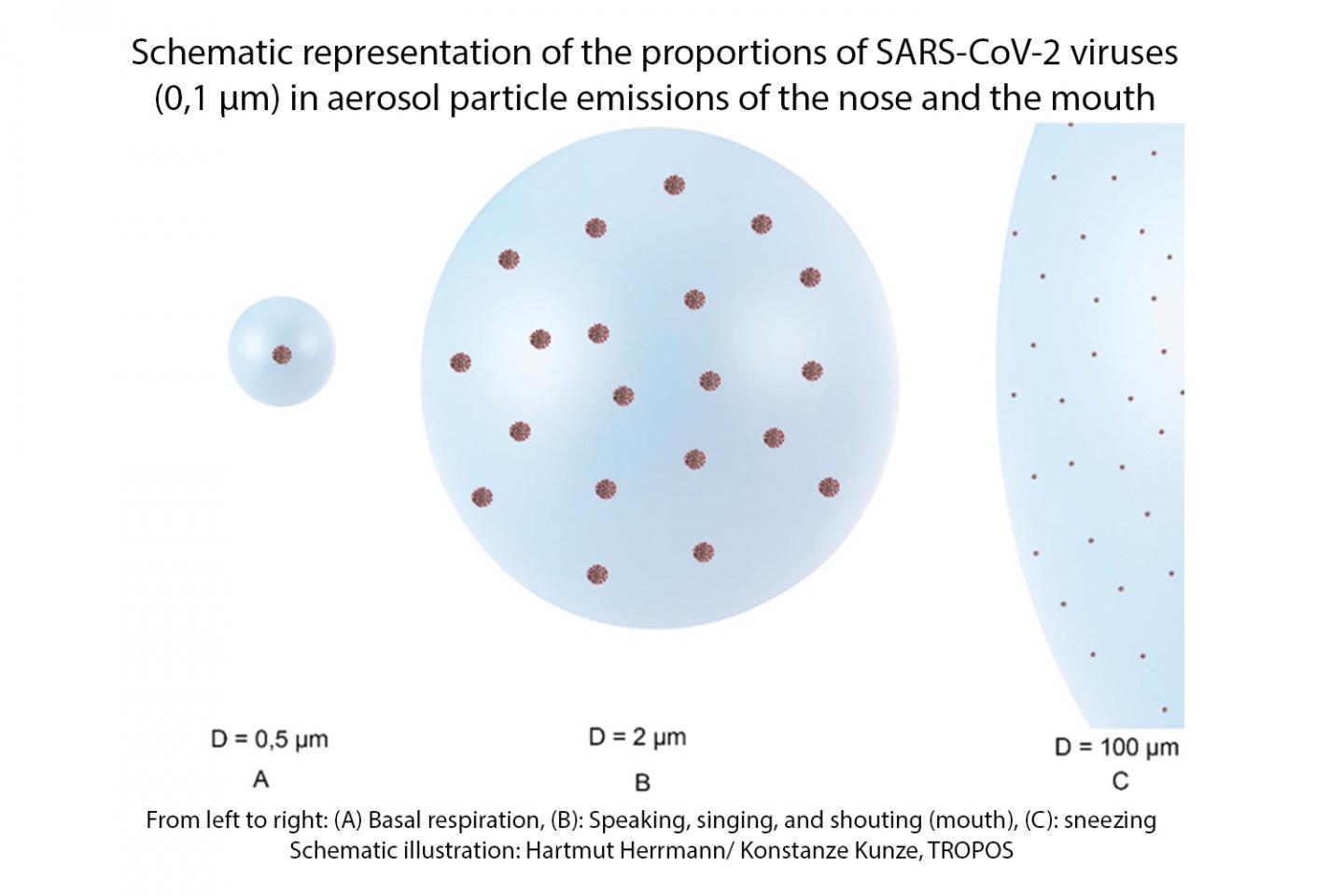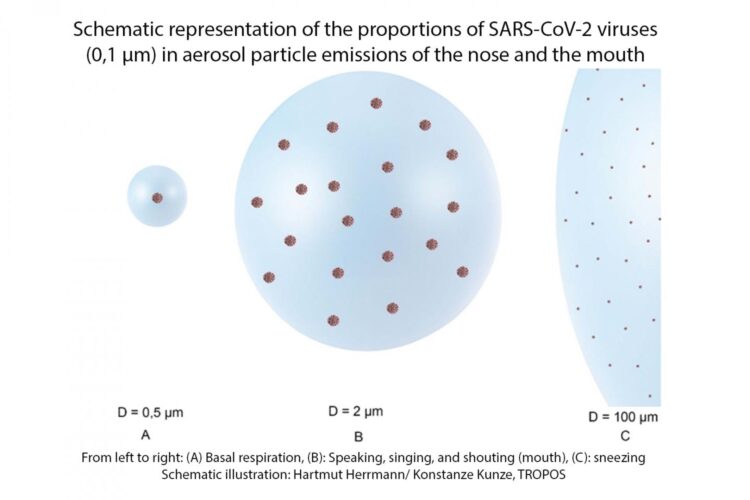Working committee particulate matter (AAF) recommends concrete countermeasures for indoor areas: masks, ventilation, air purification and overhead extraction

Credit: Hartmut Herrmann / Konstanze Kunze, TROPOS
Leipzig/Frankfurt/Main/Düsseldorf. Aerosols and their spread play an essential role in the transmission of COVID-19. However, the risk of transmission could be significantly reduced if more could be done to reduce indoor airborne viruses. The Working committee particulate matter (AAF) has therefore issued an statement with concrete recommendations. These include window ventilation, exhaust ventilation, air purification systems and CO2 measuring devices for indoor areas such as classrooms or transportation, and the increased use of N95 and FFP2 masks. These countermeasures could help in the short term to better contain the corona pandemic, especially in winter, until vaccination is effective on a large scale. They could also help in the long term to better control infections such as seasonal fluor even other pandemics in the future.
The German Working committee particulate matter (AAF) brings together experts from the fields of engineering, chemistry, physics, biology, meteorology and medicine, who are organised in the professional associations ProcessNet (DECHEMA/ VDI-GVC), Gesellschaft Deutscher Chemiker (GDCh) and VDI/DIN Commission Reinhaltung der Luft (KRdL). In its autumn meeting, the AAF discussed the role of aerosol particles in the spread of the SARS-CoV2 viruses and prepared a statement on this topic. On the basis of their expertise, the authors describe in the now published statement different aerosol types with regard to their formation, range, residence time in the air and derive recommendations for protection by various measures. The authors expressly support the current recommendations of the Robert Koch Institute (RKI), but suggest that even more should be done to reduce the number of viruses in indoor air.
The Working committee particulate matter (AAF) advises strict application of the recommendations based on the active aerosol propagation path: masks (especially the use of N95 and FFP2 masks) are helpful and necessary, ventilation is a good immediate measure and suitable air purifiers should be used.
Furthermore, the Panel concludes that more attention should be paid to the type of ventilation in addition to the measures already taken: Especially the smaller aerosol particles rise with the warm air we breathe and then spread below the ceiling. The experts on the working committee therefore recommend that in ventilation systems, care should be taken to ensure that fresh air is not supplied from top to bottom, as this leads to turbulence between the fresh air and the air we breathe and viruses can then float in the room air for longer. Ceiling fans, which are counterproductive in the current COVID 19 pandemic, would also contribute to this. Instead, care should be taken to ensure that air is actually extracted upwards. In the future, a reversal of the air supply and extraction in aircraft or public transport could help.
The panel of experts also advises to install ventilation and especially overhead exhaust suction systems in many areas at short notice, especially in classrooms or in the catering industry. Monitoring the CO2 concentration is a suitable indicator of how well the ventilation works. For cultural facilities, too, monitoring the CO2 content and thus the indoor air could later provide opportunities for normalising operation. In the Länder, funds should be made available so that ventilation, extraction, air purification systems and CO2 measuring devices can be installed in school classes. At the local level, it would be helpful if administrative regulations were relaxed and school managements were given more freedom of action. If these measures were implemented consistently, about 90 percent of all potentially viral aerosols could be removed from classrooms.
“We clearly see the human and technical effort involved in the short and medium term, but we are convinced that the appropriate consideration of the virus spread via the aerosol path can lead to a short-term and also sustainable containment of the current incidence of infection. Such investments would also be beneficial for later, for example for the air quality in classrooms”, explains Prof. Hartmut Herrmann of the Leibniz Institute for Tropospheric Research (TROPOS), who is chairman of the Working Committee on Particulate Matter (AAF). Herrmann also contributes torecommendations by an international group of aerosol researchers) and via the VDI/DIN Commission on Air Pollution Control (KRdL), which were incorporated into specific recommendations for German conditions. Even if the World Health Organization (WHO) still pays too little attention to this, experts have long been convinced that aerosols, i.e. tiny suspended particles in the air, contribute strongly to the spread of the SARS-CoV2 viruses. “We are aware that the technical implementation of more efficient ventilation measures is probably one of the most demanding measures in the current situation in Germany. However, protection against infection from virus-contaminated aerosol particles in indoor rooms and means of transport through improved ventilation technology is particularly important in the cold winter months in order to avoid corona superspreader events”, emphasises Prof. Peter Wiesen from the Bergische Universität Wuppertal, who is one of the authors of the statement.
Protective measures against the spread of SARS-CoV-2 via indoor aerosols currently pose major challenges for many sectors of society. The risk of infection is particularly high in hospitals and nursing homes because infected and healthy people can stay sometimes in the same room for long periods of time. According to media reports, COVID-19 infections are already reported in almost one tenth of the 12,000 old people’s homes and nursing homes in Germany. Homes are now also considered as hotspot for the spread of the virus among new infections in Saxony. An international group of aerosol researchers proposes therefore a variety of measures to prevent the spread of the virus in hospitals and nursing homes. It is particularly important to develop an appropriate strategy to protect healthcare workers from airborne transmission. Their recommendations in the International Journal of Environmental Research and Public Health include regular ventilation, controlling fresh air consumption via CO2 monitor and using humidifiers to keep the relative humidity indoors at 40 to 60 percent. If it is not possible to ventilate sufficiently, the use of portable air purifiers are also advisable.
In addition to the recommendations already made by the Robert Koch Institute and the National Academy of Sciences Leopoldina in Germany, the Working Committee sees an opportunity to take additional protective measures to contain the Covid-19 pandemic, initially in the short term, until a vaccine has reached a really broad section of the population. In addition, these measures could in the future also help to reduce infections such as seasonal influenza, which are spread through the air.
###
Publications:
Covid-19 and the role of aerosol particles – Statement of the Working committee particulate matter (AAF) of DECHEMA/ProcessNet, GDCh and KRdL
https:/
(The Working committee particulate matter (AAF) is a body of the following scientific associations: DECHEMA (Gesellschaft für Chemische Technik und Biotechnologie e.V. Frankfurt; ProcessNet: Platform for Chemical Process Engineering of DECHEMA and VDI-GVC (with VDI: Verein Deutscher Ingenieure e.V., Düsseldorf and GVC:Gesellschaft für Verfahrenstechnik und Chemieingenieurwesen im VDI e.V. Düsseldorf; GDCh (Gesellschaft Deutscher Chemiker e.V., Frankfurt) and KRdL (VDI/DIN Commission Reinhaltung der Luft (KRdL) – Standards Committee, Düsseldorf).
This statement is supported and co-sponsored by the Leibniz Institute for Tropospheric Research (TROPOS) and the Gesellschaft für Aerosolforschung (GAeF).
The statement was drafted by H. Herrmann, P. Wiesen, R. Zellner and C. Zetzsch with contributions from E. Hösen-Seul, W. Koch, U. Krämer, G. Lammel, A. Mayer, S. Metzger, S. Nehr, U. Pöschl, E. Schmidt and K. Schwarz.)
Ahlawat, A.; Mishra, S.K.; Birks, J.W.; Costabile, F.; Wiedensohler, A. Preventing Airborne Transmission of SARS-CoV-2 in Hospitals and Nursing Homes. Int. J. Environ. Res. Public Health 2020, 17, 8553.
DOI: 10.3390/ijerph17228553
https:/
Media contacts:
Prof. Hartmut Herrmann
Head of Working committee particulate matter (AAF)
Head of the Atmospheric Chemistry Department at the Leibniz-Institute for Tropospheric Research (TROPOS), Leipzig
Phone: +49-341-2717- 7024
https:/
and
Tilo Arnhold
TROPOS Public Relations
Phone: +49-341-2717-7189
https:/
Further information:
Working Committee particulate matter (AAF)
https:/
FAQs on Protecting Yourself from COVID-19 Aerosol Transmission
https:/
KRdL version under
https:/
Support for the appeal of protective measures against the airborne spread of Covid-19
https:/
Media Contact
Tilo Arnhold
[email protected]
Original Source
https:/
Related Journal Article
http://dx.






